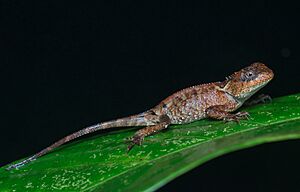Brown pricklenape facts for kids
Quick facts for kids Brown pricklenape |
|
|---|---|
 |
|
| Conservation status | |
| Scientific classification | |
| Genus: |
Acanthosaura
|
| Species: |
lepidogaster
|
 |
|
| Distribution range of Acanthosaura lepidogaster | |
| Synonyms | |
|
Calotes lepidogaster CUVIER 1829 |
|
The Brown Pricklenape (Acanthosaura lepidogaster) is a fascinating type of lizard. It belongs to a group of lizards called agamids. These lizards are known for their unique looks.
This particular lizard gets its name from the small, spiky scales on its body. These scales make it look a bit "prickly." It's a cool example of how animals adapt to their surroundings.
Contents
What is a Brown Pricklenape?
The Brown Pricklenape is a medium-sized lizard. It has a sturdy body and a tail that can be quite long. Its skin is usually brown, helping it blend in with trees and rocks. This camouflage is very important for hiding from predators.
Spiky Features
One of the most noticeable things about the Brown Pricklenape is its spiky scales. It has a row of spikes along its back. It also has spikes around its head and neck. These spikes are not just for show. They help protect the lizard from animals that might try to eat it.
How Big Do They Get?
Brown Pricklenapes can grow to be about 25 to 30 centimeters (10 to 12 inches) long. This measurement includes their body and their long tail. They are not huge lizards, but they are big enough to be easily spotted if you know where to look.
Where Do Brown Pricklenapes Live?
Brown Pricklenapes are found in several countries in Southeast Asia. Their home range includes Thailand, Vietnam, Myanmar, Laos, and China. They prefer places with lots of trees and plants.
Their Habitat
These lizards love forests, especially tropical and subtropical ones. You can often find them on tree trunks, branches, or among the leaves. They are very good at climbing. Their claws help them grip onto rough surfaces.
What Do They Eat?
Like many lizards, the Brown Pricklenape is an insectivore. This means it mostly eats insects. They are skilled hunters. They wait patiently for their prey to come close.
Hunting Habits
Their diet includes a variety of insects. They might eat crickets, grasshoppers, beetles, and other small bugs. They use their quick movements to catch their meals. This helps keep insect populations in check in their environment.
Conservation Status
The Brown Pricklenape is currently listed as "Least Concern" (LC) by the IUCN. This means that, for now, their population is stable. They are not considered to be in danger of extinction.
Why Conservation Matters
Even though they are not currently endangered, it's important to protect their habitats. Forests are vital for many species, including these lizards. Protecting forests helps all the animals that live there.
Interesting Facts
- Brown Pricklenapes are active during the day. This makes them diurnal animals.
- They use their vision to spot prey and predators.
- They are part of the Acanthosaura genus. This group includes many other spiky lizards.
- The first scientific description of this lizard was made by Georges Cuvier in 1829.


